Stabilized Wood for Knife Handles: Understanding the Process and Benefits
- February 5, 2024
- 0 comment
For knife enthusiasts and makers, the journey to crafting the ideal knife doesn’t stop at the blade’s edge; the handle holds equal importance. Amidst a variety of materials from sleek metals to classic woods and modern synthetics, stabilized wood shines as a top contender for crafting exquisite knife handles. This exploration into stabilized wood reveals the unique process it undergoes and the distinct advantages it brings to the table, highlighting why it captures the hearts of those in pursuit of the ultimate knife.
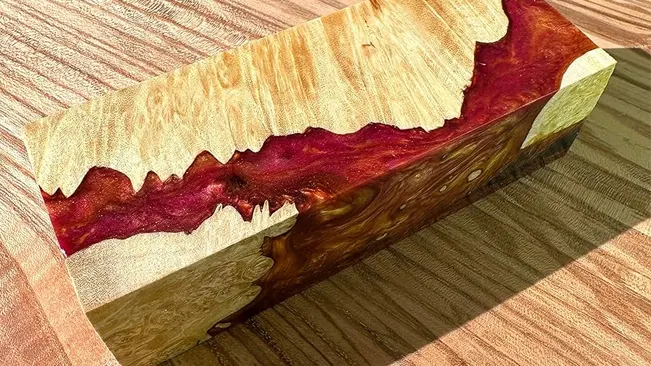
What is Stabilized Wood?
Stabilized wood is natural wood that has been impregnated with a stabilizing resin. This process not only enhances the wood’s physical properties but also preserves its natural beauty. The result is a material that combines the best of nature and technology, offering an ideal balance of durability and aesthetics.
The Stabilization Process
Expanding on the stabilization process involves delving deeper into each step to understand the meticulous attention to detail required to transform ordinary wood into durable, beautiful stabilized wood suitable for high-quality knife handles and other fine crafts. Here’s a more detailed exploration:
Selection of Wood
The journey to creating stabilized wood begins with the careful selection of wood. Artisans and craftsmen look for pieces that not only exhibit structural integrity but also possess distinctive grains and patterns, which will be enhanced through the stabilization process. This stage is crucial because the inherent beauty and uniqueness of the wood are what make the final product stand out. Species with interesting colors, grain configurations, and natural character are preferred, as these features will be accentuated and preserved by the stabilization.
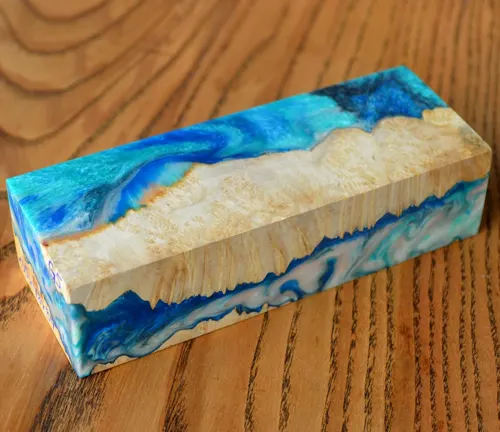
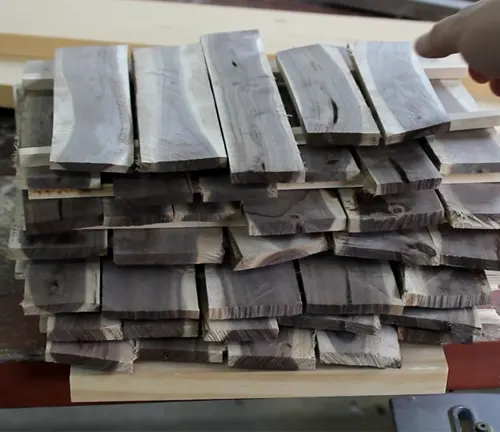
Drying
Once selected, the wood must undergo a thorough drying process. This step is essential to ensure that all moisture is removed from the wood, preventing any future decay or warping and allowing the stabilizing resin to fully penetrate the wood’s fibers. Drying is typically achieved through the use of kilns or air drying, with the process taking anywhere from several days to weeks, depending on the type of wood and its initial moisture content. The goal is to achieve a moisture content close to zero, which is ideal for stabilization.
Impregnation
The dried wood is then ready for impregnation, the core step in the stabilization process. The wood is placed in a vacuum chamber where it is submerged in a stabilizing resin. The vacuum ensures that air pockets within the wood’s structure are evacuated, allowing the resin to penetrate deeply into even the tiniest pores and cavities. Different types of resins can be used, each offering unique properties to the final product, such as increased hardness, color enhancement, or improved resistance to heat and chemicals. This stage requires precise control of the vacuum and immersion time to ensure optimal infusion.

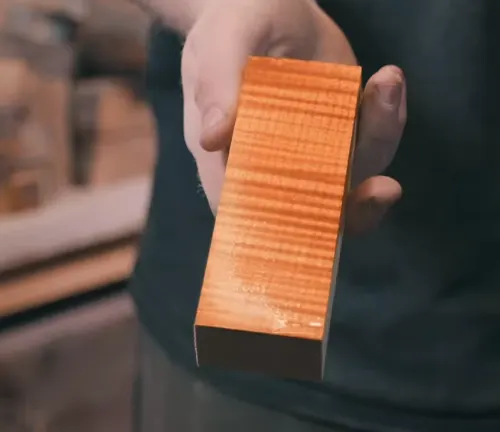
Curing
After impregnation, the resin-infused wood must be cured to harden the resin, thereby locking in the enhanced properties. Curing is typically achieved by applying heat, either in a specialized oven or through the use of ultraviolet light, depending on the type of resin used. The curing process solidifies the resin, ensuring it bonds permanently with the wood fibers, transforming the wood into a much stronger and more resilient material. The duration and temperature of the curing process are carefully controlled to prevent any damage to the wood while ensuring the resin is fully cured.
This comprehensive process, from selection to curing, transforms ordinary wood into stabilized wood, a material that retains the natural beauty and uniqueness of wood while significantly enhancing its physical properties. Each piece of stabilized wood is a testament to the artisan’s skill and attention to detail, ready to be fashioned into knife handles and other items that require durability, beauty, and a touch of natural elegance.
Benefits of Stabilized Wood for Knife Handles
The benefits of choosing stabilized wood for knife handles are numerous:
Durability
The infusion of stabilizing resin significantly enhances the wood’s resilience, making it an ideal choice for knife handles that are expected to endure rigorous use. This durability stems from the wood’s newfound resistance to environmental factors that typically degrade natural materials:
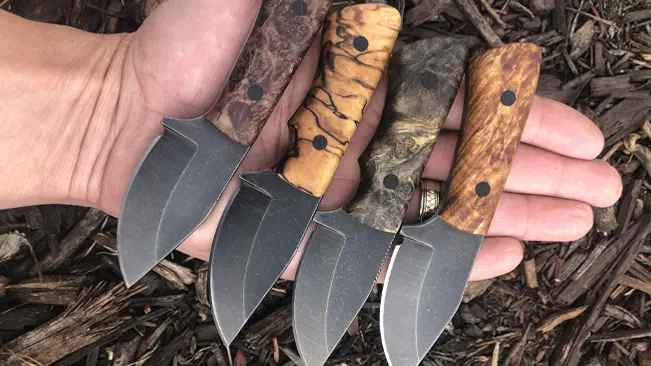
Water Resistance: Unlike untreated wood, which can absorb moisture and swell or warp, stabilized wood remains unaffected by humidity or direct contact with water. This quality is particularly beneficial for kitchen knives or outdoor gear exposed to the elements.
Heat Resistance: The stabilizing process improves the wood’s tolerance to heat, preventing it from drying out, cracking, or warping when exposed to high temperatures, thus preserving the handle’s integrity over time.
Resistance to Chemicals and Stains: Stabilized wood is less likely to react with acidic substances or stain upon contact with various fluids, making it easier to keep the knife handle clean and pristine.
Aesthetic Appeal
Stabilized wood retains all the natural beauty of wood while enhancing its visual characteristics, making each knife handle a piece of art:
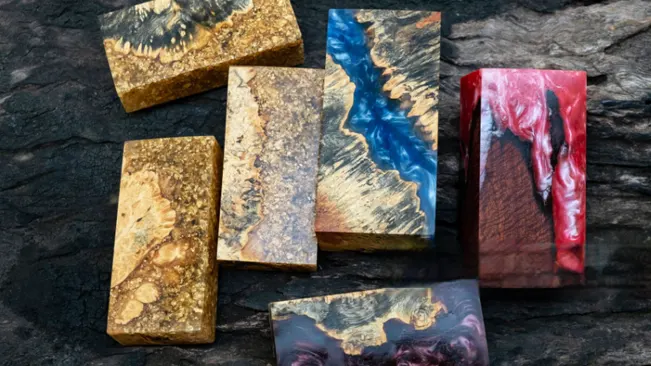
Enhanced Grain Patterns: The resin accentuates the wood’s natural grain, making patterns more pronounced and visually striking. This can turn an ordinary knife into a collector’s item or a showcase piece.
Color Depth and Variety: Through the stabilization process, colors become richer and more vibrant. Additionally, dyes can be added to the resin to achieve unique color effects, offering endless possibilities for customization and personalization.
Uniqueness: No two pieces of stabilized wood are exactly alike. Each handle made from this material is one-of-a-kind, reflecting the natural variations in the wood and the artisan’s craftsmanship.
Maintenance
Ease of maintenance is another compelling reason for choosing stabilized wood for knife handles, making it a practical choice for both professional chefs and outdoor enthusiasts:
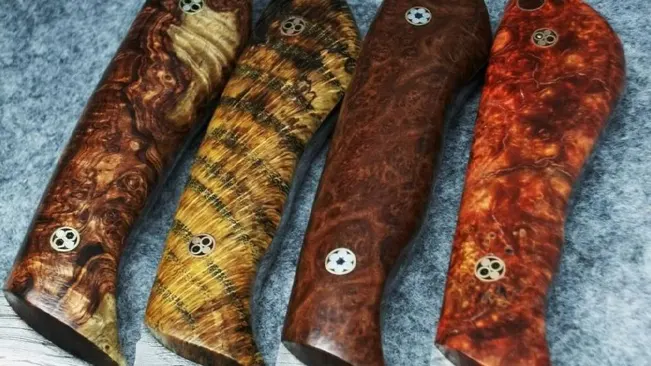
Low Care Requirements: Stabilized wood handles do not require the regular oiling or special storage conditions that traditional wood might need. Simple cleaning with soap and water is often enough to maintain their appearance.
Longevity: Thanks to its enhanced durability, a stabilized wood handle can last for decades without significant signs of wear, ensuring that the knife remains a valuable tool or heirloom piece for years to come.
Resistance to Swelling and Shrinking: Changes in humidity can cause traditional wood to swell or shrink, leading to a loose fit between the handle and the blade. Stabilized wood’s resistance to moisture eliminates this concern, maintaining a stable and comfortable grip over time.
Comparing Stabilized Wood to Other Materials
When compared to traditional wood, synthetics, and metals, stabilized wood offers a superior combination of durability, beauty, and ease of maintenance. It provides a natural look with enhanced properties that other materials cannot match, making it a top choice for high-quality knife handles.
| Feature | Stabilized Wood | Natural Wood | Micarta | G10 | Aluminum | Titanium |
|---|---|---|---|---|---|---|
| Durability | High | Moderate | High | High | Very High | Extremely High |
| Moisture Resistance | Excellent | Low | Excellent | Excellent | Excellent | Excellent |
| Stability | Excellent | Low | Excellent | Excellent | Excellent | Excellent |
| Weight | Light to Medium | Light | Medium | Heavy | Light | Heavy |
| Warmth | Warm | Warm | Neutral | Neutral | Cold | Cold |
| Grip | Good | Good | Excellent | Good | Good | Excellent |
| Workability | Moderate | Easy | Easy | Easy | Difficult | Difficult |
| Cost | High | Low | Medium | Medium | High | High |
| Aesthetics | Unique natural beauty | Varied natural beauty | Consistent colors & patterns | Consistent colors & patterns | Metallic finish | Metallic finish |
| Common Uses | Knife handles, pens, scales, cutting boards | Furniture, construction, art | Knife handles, gun grips, scales | Knife handles, gun grips, scales | EDC gear, knife handles | Knife handles, EDC gear |
Applications of Stabilized Wood
Stabilized wood, renowned for its enhanced durability and unique aesthetic appeal, is a versatile material utilized across various industries beyond knife handles. Its applications include:
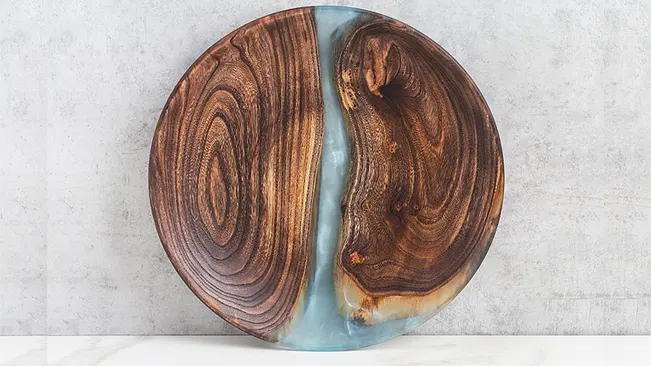
- Fine Jewelry: Offers a distinctive look with vibrant colors and rich grain patterns, making jewelry pieces like earrings and pendants uniquely appealing and durable for everyday wear.
- Musical Instruments: Used in guitars, violins, and woodwinds for its beauty and potential impact on tone and resonance, stabilized wood also provides durability against the rigors of travel.
- Luxury Automotive Interiors: Adds a touch of sophistication to dashboards, trim, and panels, with its rich textures and easy maintenance, making it ideal for high-end vehicle customization.
Stabilized wood’s blend of natural beauty and practical benefits such as resistance to environmental factors and low maintenance needs make it a popular choice across these fields, offering both aesthetic elegance and long-lasting utility.
Choosing the Right Stabilized Wood for Your Knife
Selecting the right stabilized wood involves considering the color, grain, and hardness that match your aesthetic and functional requirements. Tips for selection include consulting with experienced craftsmen and suppliers known for their quality materials.
Conclusion
Stabilized wood represents a pinnacle in material choice for knife handles, offering unmatched durability, beauty, and ease of maintenance. By understanding the stabilization process and its benefits, craftsmen and enthusiasts can make informed decisions that elevate their creations from mere tools to works of art. Consider stabilized wood for your next knife project and experience the difference it can make.
10 FAQs about Stabilized Wood for Knife Handles
- What is stabilized wood?
Stabilized wood is natural wood that has been impregnated with a special resin to enhance its durability, resistance to moisture, and overall strength, making it an ideal material for knife handles and other high-utility items. - How is wood stabilized?
The process involves drying the wood to remove all moisture, vacuum-sealing it with a stabilizing resin, and then curing the resin-infused wood under heat to solidify the mix, resulting in a much stronger and more durable material. - Why use stabilized wood for knife handles?
Stabilized wood combines the beauty of natural wood with enhanced physical properties, such as increased durability, water resistance, and improved strength, making it perfect for knife handles that are both functional and aesthetically pleasing. - What are the benefits of stabilized wood over traditional wood?
Unlike traditional wood, stabilized wood is less prone to warping, cracking, or shrinking because the stabilizing resin fills in the pores and solidifies the structure, offering superior durability and moisture resistance. - Can any type of wood be stabilized?
While most types of wood can be stabilized, woods with more porous structures tend to absorb the resin better, resulting in a more effective stabilization process. The suitability can vary depending on the specific characteristics of the wood. - Is stabilized wood environmentally friendly?
Stabilized wood is generally considered an environmentally friendly option because it can enhance the life span of wood products, reducing the need for frequent replacements. However, the environmental impact also depends on the type of resin used in the process. - How do I care for a knife handle made of stabilized wood?
Stabilized wood handles are low maintenance compared to traditional wood. They can be cleaned with a damp cloth and mild soap. Avoid prolonged exposure to extreme temperatures and harsh chemicals to maintain the handle’s integrity. - Can I stabilize wood at home?
Yes, with the right equipment and materials, such as a vacuum chamber, stabilizing resin, and a curing oven, you can stabilize wood at home. However, achieving professional results requires practice and understanding of the process. - What makes stabilized wood different from other knife handle materials?
Stabilized wood offers a unique blend of natural beauty and enhanced physical properties, setting it apart from synthetic materials and untreated woods. It provides a warm, organic feel that synthetic materials cannot replicate, along with improved performance characteristics. - Where can I buy stabilized wood for knife handles?
Stabilized wood can be purchased from specialty suppliers, woodworking shops, and online marketplaces that cater to knife makers and woodworking enthusiasts. Look for reputable dealers who provide quality, stabilized wood suitable for knife handle making.
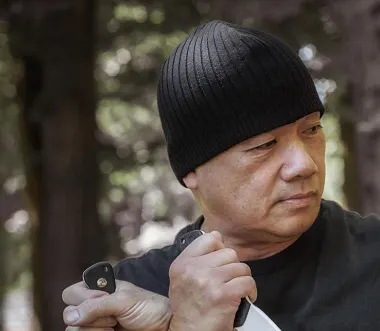
Kerith Simon
As an expert with over ten years of dedicated experience in knife defense, my professional journey is anchored in a profound commitment to the safety and empowerment of individuals through specialized education. My expertise is not only grounded in practical self-defense techniques but also extends to a scholarly understanding of knife functionality, which I have meticulously documented in my authoritative series, This work stands as a testament to my deep engagement with the subject, offering readers critical insights into the nuances of knife selection and usage across various contexts. My approach to teaching and content creation is informed by a rigorous methodology and a continuous pursuit of knowledge, ensuring that the strategies and insights I provide are both effective and scientifically sound. Through a combination of hands-on workshops, comprehensive seminars, and well-researched publications, I strive to elevate the standard of knife defense education, making it accessible and reliable for those seeking to enhance their security and proficiency in this essential skill.

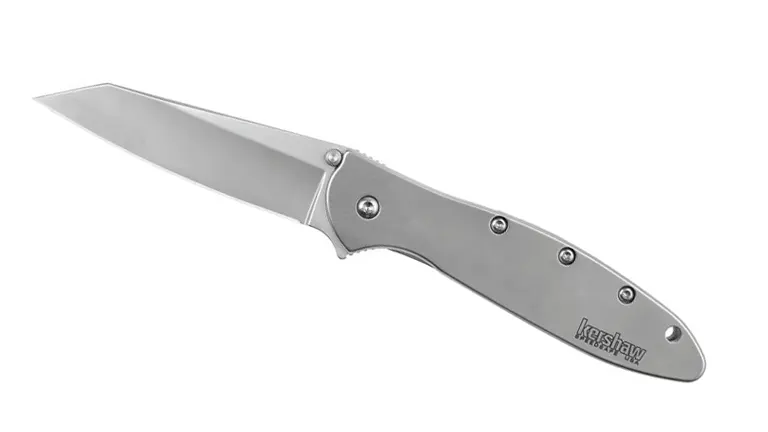

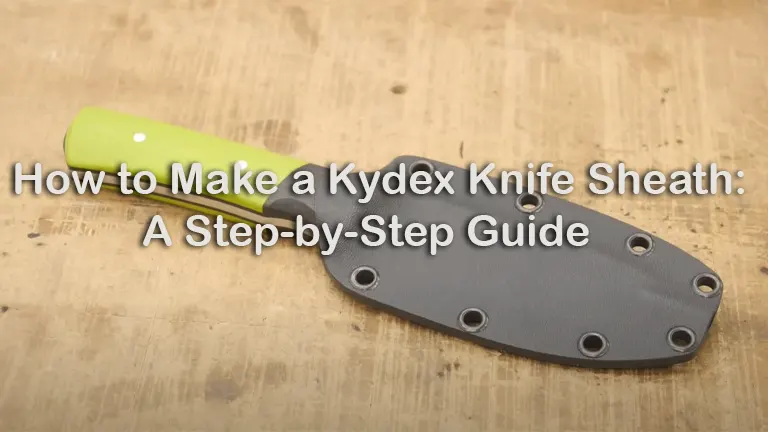
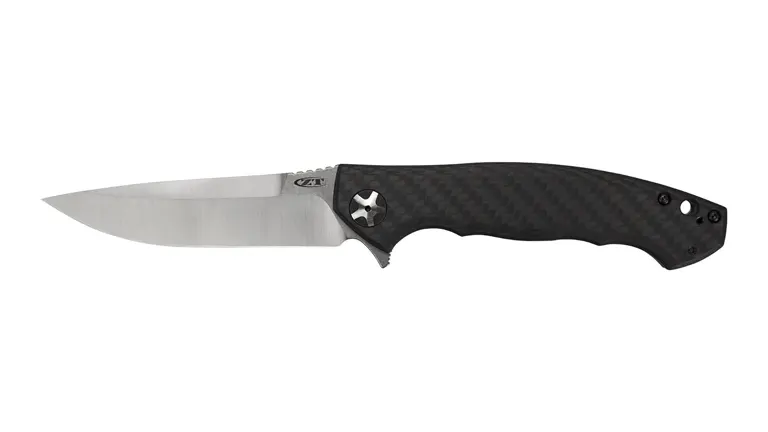



Leave your comment